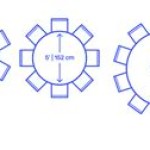How Tall Is A Table Saw?
Determining the height of a table saw is crucial for ensuring safe and efficient woodworking practices. While there isn't a universal height standard, understanding the typical dimensions and factors influencing table saw height allows users to optimize their workspace and minimize the risk of injury. The height of a table saw is generally determined by the height of the table saw's table. This measurement is taken from the floor to the top surface of the table.
The standard table saw height is frequently cited as 36 inches. This dimension is often based on ergonomic considerations, aiming to position the work surface at a comfortable level for a wide range of users. This height promotes a neutral posture, reducing strain on the back and shoulders during prolonged use. However, this "standard" should not be considered absolute. The actual height can vary significantly depending on the specific type of table saw, the presence of adjustable legs or mobile bases, and the user's personal preferences or physical requirements.
Different categories of table saws, such as contractor saws, cabinet saws, and portable jobsite saws, often exhibit variations in height. Contractor saws, for instance, may be slightly lower than heavier cabinet saws. Portable jobsite saws, designed for transport and setup on temporary worksites, tend to prioritize compactness and may have a lower profile. Furthermore, adding aftermarket accessories, like mobile bases that enable movement around the shop, will inevitably affect the overall height of the table saw.
Therefore, rather than relying solely on a general "standard," it is vital to measure the specific table saw being used and to assess the suitability of that height for the individual user. Careful consideration of these factors contributes to a safer and more comfortable woodworking experience.
Factors Influencing Table Saw Height
Several key factors contribute to the overall height of a table saw. These factors should be considered when selecting a table saw or adjusting an existing one to optimize ergonomics and safety.
Type of Table Saw: As previously mentioned, the type of table saw significantly influences its height. Cabinet saws, known for their robust construction and precision, typically have a larger cabinet base that contributes to a greater overall height. Contractor saws, designed to offer a balance of power and portability, tend to be somewhat lower to the ground. Jobsite saws, prioritizing portability and ease of setup, often have the lowest profile of the three. Therefore, understanding the inherent characteristics of each saw type is crucial for predicting its approximate height.
Presence of a Mobile Base: Mobile bases are frequently added to table saws to facilitate movement around the workshop. These bases usually consist of a wheeled frame that raises the saw off the ground. While increasing mobility, a mobile base inevitably adds several inches to the overall height of the table saw. The specific amount of added height depends on the design and construction of the base itself. Some mobile bases are designed to add minimal height, while others provide a more substantial lift. Before purchasing a mobile base, it is important to consider its impact on the saw's overall height and whether the resulting height will be appropriate for the user.
Adjustable Legs or Shims: Some table saws come equipped with adjustable legs, allowing users to fine-tune the height of the saw. These adjustable legs can be particularly useful for compensating for uneven floors or for accommodating users of different heights. Even if the table saw does not come with adjustable legs, shims can be used to raise the height of the saw, although this is generally a less stable and less desirable solution. Shims are thin pieces of material, typically wood or plastic, that are placed under the legs of the saw to raise it incrementally. While shimming can be effective for minor height adjustments, it is important to ensure that the saw remains stable and does not wobble.
By understanding how these factors influence table saw height, woodworkers can make informed decisions about saw selection, accessory installation, and workstation setup.
Ergonomic Considerations for Table Saw Height
Beyond the standardized measurements, ergonomic considerations play a crucial role in determining the optimal table saw height for individual users. Using a table saw that is too high or too low can lead to discomfort, fatigue, and potentially, long-term musculoskeletal issues.
Neutral Posture: The primary goal of ergonomic design is to promote a neutral posture, minimizing stress on the body. When using a table saw, the ideal height should allow the user to stand upright with their shoulders relaxed and their elbows bent at approximately 90 degrees. This posture reduces strain on the back, shoulders, and wrists. If the saw is too low, the user will be forced to bend over, placing excessive stress on the lower back. Conversely, if the saw is too high, the user will have to raise their shoulders, leading to fatigue and discomfort in the neck and shoulders.
Arm Reach and Control: The height of the table saw also affects arm reach and control. The user should be able to comfortably reach all areas of the table surface without straining or overextending. Proper arm reach is essential for maintaining control over the workpiece during cutting operations. If the saw is too high, the user may have difficulty reaching the far side of the table, compromising control and potentially increasing the risk of kickback. Likewise, if the saw is too low, the user may have to lean excessively, reducing their ability to maintain a stable and controlled grip on the workpiece.
Personal Preference and Physical Requirements: Ultimately, the optimal table saw height is a matter of personal preference and physical requirements. Individuals with back problems or other physical limitations may require a different height than those without such limitations. It is essential to experiment with different heights, if possible, to find the most comfortable and efficient working position. Consider using adjustable legs, shims, or a mobile base to fine-tune the saw's height to meet individual needs. It may be helpful to consult with a physical therapist or other healthcare professional to determine the most ergonomic setup for a particular individual.
Prioritizing ergonomic considerations when setting up a table saw can significantly improve both comfort and safety, leading to a more enjoyable and productive woodworking experience.
Measuring Your Table Saw's Height Accurately
To determine if a table saw's height is appropriate, accurate measurement is essential. This process requires specific tools and a clear understanding of where to measure from.
Tools Required: The primary tool needed for measuring table saw height is a standard measuring tape. A level can also be helpful to ensure the saw's table surface is truly horizontal, providing a more accurate measurement. A straight edge, such as a long ruler or piece of lumber, can also be used to visually confirm the table's levelness. Before beginning the measurement, ensure that the measuring tape is in good working order and that the markings are clear and easy to read.
Measurement Points: The measurement should be taken from the floor to the highest point of the table surface. This ensures that any slight variations in the table's levelness are accounted for. It is advisable to take multiple measurements at different points on the table and then average them to obtain a more accurate reading. Pay attention to any accessories or attachments that might be protruding from the table surface and skewing the measurement.
Accounting for Mobile Bases and Accessories: If the table saw is equipped with a mobile base, the measurement should be taken from the floor to the top of the table with the mobile base in its operational position. This will provide the true working height of the saw. Similarly, if any accessories, such as an outfeed table, are attached to the saw, it is important to consider their impact on the overall height. An outfeed table, for example, can sometimes be adjusted independently of the main table, so it is crucial to ensure that it is set at the correct height relative to the table saw's surface.
By employing proper measuring techniques and accounting for all relevant factors, users can obtain an accurate assessment of their table saw's height and determine whether adjustments are necessary.
Ultimately, understanding the typical height range of table saws, the factors influencing height variations, and the importance of ergonomic considerations empowers woodworkers to create a safer, more comfortable, and more efficient workspace. Accurate measurement is a key component in this process, ensuring that the table saw is properly adjusted to meet the individual needs of the user.
What Is The Ideal Height For A Work Bench Router Table Or Saw Relative To User S Quora

What S The Ideal Height For Your Table Saw Stand

Challenge Extreme Table Saw Height Adjustment

Tall Tablesaw Fence Popular Woodworking

Tall Tablesaw Fence Popular Woodworking

Raised Panel Table Saw Jig Toolbox Thisiscarpentry

Easy On Off Tall Fence Wood

World Of Wood Raised Panels On The Table Saw

Raised Panel Tablesaw Jig Popular Woodworking

Dual Purpose Fence Woodsmith








